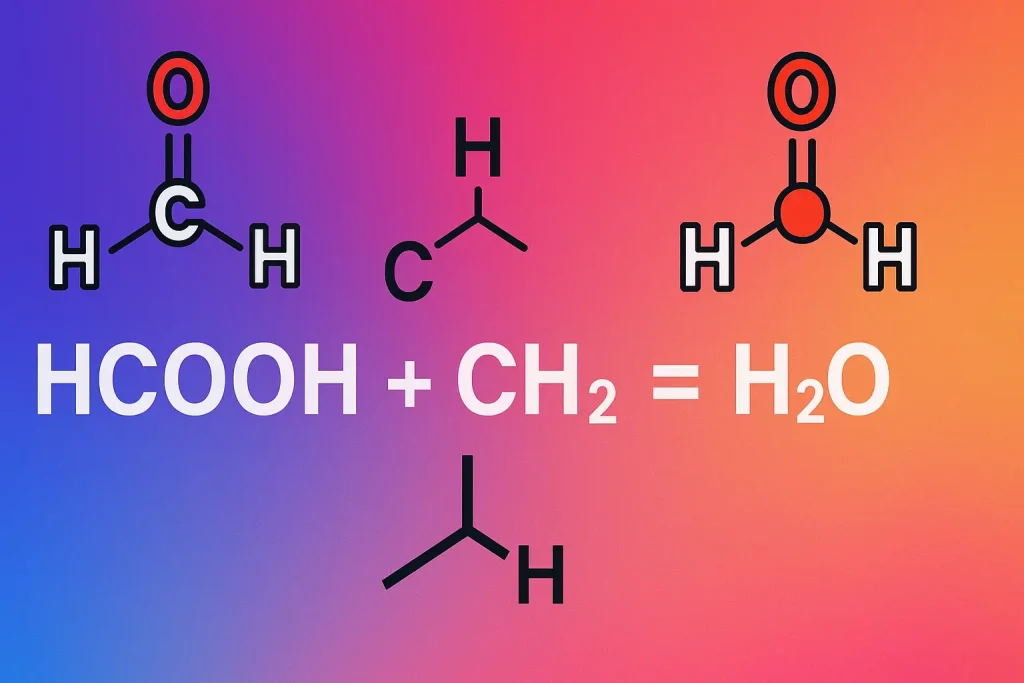
Formic acid (HCOOH), the methylene group (CH₂), and water (H₂O) are three essential components in organic chemistry. hcooch ch2 h2o when studied together, their reaction provides deep insights into acid-base behavior, molecular interaction, and practical industrial applications. This article explores these compounds from every angle, offering expert clarity, powerful relevance, and exciting potential for learners and professionals alike.
Whether you’re a student, researcher, or curious mind, this comprehensive exploration breaks down each concept clearly and efficiently. You’ll understand not just the chemistry, but why it matters—and how it applies in the real world. From reaction mechanisms to biological implications, every aspect is covered with scientific accuracy and real-world value.
What is HCOOH CH₂ H₂O?
The phrase HCOOH + CH₂ + H₂O refers to the interaction between formic acid (HCOOH), a methylene group (CH₂), and water (H₂O). Though this expression isn’t a conventional balanced chemical equation, it prompts exploration of acid-base chemistry, reaction mechanisms, and aqueous organic chemistry.
When these components are brought together, particularly in the context of aqueous solutions, formic acid undergoes dissociation, and the methylene group may participate in reaction chains or act as an intermediate. This mixture represents a foundational scenario in the study of organic reactions and acid-base interactions—rich in insight and academic relevance.
Also Read: https://gossipsmag.co.uk/sociallbizmagazine-com/
The Chemical Nature and Structure of Formic Acid (HCOOH)
Formic acid, with the chemical formula HCOOH, is the simplest member of the carboxylic acid family. It features a carboxyl group attached to a single hydrogen atom. This unique configuration makes formic acid both structurally simple and chemically reactive. Its molecular structure includes a carbonyl group (C=O) and a hydroxyl group (-OH) bonded to the same carbon, enabling proton donation.
Scientifically speaking, formic acid is renowned for its weak acid dissociation in water and versatile reactivity. Its behavior in aqueous solutions is pivotal to understanding broader organic acid reactions. It acts as a proton donor, making it an ideal compound to study in acid-base chemistry, particularly for its capacity to form the formate ion (HCOO⁻).
Understanding CH₂: The Role and Behavior of the Methylene Group
- CH₂ is a fundamental building block in organic chemistry
- Highly reactive due to unpaired electrons or double-bond potential
The methylene group (CH₂) is a divalent fragment often seen in hydrocarbons. While it’s not stable as a free molecule, it plays a crucial role in reaction pathways—especially in synthetic and organic reaction mechanisms. Methylene can serve as an intermediate or part of more complex structures like alkenes or carbocations.
Its electron configuration makes CH₂ an exciting player in both theoretical and applied chemistry. Though fleeting, methylene is central in polymerization, functional group transformations, and energy transfer mechanisms in biochemical reactions. In the context of formic acid, it may not react directly in isolation but can enhance the system’s reactivity under specific conditions.
What Happens When HCOOH Reacts with Water (H₂O)?
- HCOOH donates a proton to water, creating H₃O⁺ and HCOO⁻
- This is a classic acid-base equilibrium reaction
When formic acid reacts with water, it undergoes partial ionization. In this process, it donates a proton (H⁺) to a water molecule, forming the hydronium ion (H₃O⁺) and the formate ion (HCOO⁻). This behavior illustrates weak acid dissociation and is key to understanding acid strength, aqueous solution reactions, and proton transfer chemistry.
This simple yet powerful reaction teaches essential principles of reaction equilibrium and acid-base interactions. It’s also a cornerstone in evaluating the pKa of weak acids. Importantly, this reaction is reversible, meaning it reaches a balance in solution rather than going to completion, showcasing dynamic chemical behavior.
The Reaction: HCOOH + CH₂ → H₂O — Interpreted and Explained
Although not a traditional reaction, the phrase HCOOH + CH₂ → H₂O can be interpreted as a scenario where formic acid, under certain conditions, interacts with a methylene group—resulting in the evolution or involvement of water. While this reaction isn’t typically balanced or found in textbooks, it serves as a conceptual foundation.
A more accurate representation might involve hydrolysis, dehydration, or condensation involving formic acid and methylene intermediates. This interpretation allows us to explore complex organic compound behavior and how functional groups in HCOOH interact with reactive intermediates like CH₂. It’s a gateway to discussing deeper reaction mechanisms and acid-base chemistry principles.
Dissociation of Formic Acid in Aqueous Solutions
When dissolved in water, HCOOH dissociates partially. The reaction:
HCOOH+H2O⇌HCOO−+H3O+\text{HCOOH} + \text{H}_2\text{O} ⇌ \text{HCOO}^- + \text{H}_3\text{O}^+HCOOH+H2O⇌HCOO−+H3O+
is central to the study of acid dissociation equilibrium. The formate ion remains stable due to resonance, and the hydronium ion contributes to the solution’s acidity.
This reaction is influenced by concentration, temperature, and solvent nature. It’s used in titrations and is ideal for demonstrating weak acid behavior. Its predictable yet insightful properties make it a model compound for teaching acid-base chemistry.
Molecular Interaction Between Formic Acid and Water
The interaction between formic acid and water hinges on hydrogen bonding. The hydroxyl (-OH) group of formic acid forms strong interactions with water molecules, facilitating proton transfer and stabilizing the resulting ions.
These interactions influence solubility, ionization, and electrical conductivity. It’s a perfect example of how molecular structure affects macroscopic properties. This kind of behavior is not just theoretical—it has real-world implications in biochemistry, pharmaceuticals, and industrial formulations.
Understanding Acid-Base Behavior in Organic Reactions
Acids like formic acid serve as proton donors, while bases accept these protons. This classic Brønsted-Lowry theory helps explain many reactions, from buffer systems to esterification.
By observing HCOOH’s dissociation, we gain insight into how electron pairs are exchanged and how reaction equilibrium is established. This is central to understanding biological systems, pH regulation, and industrial synthesis.
Formation of Formate Ion and Hydronium Ion from HCOOH
The formate ion (HCOO⁻) is produced when formic acid loses a proton. This ion is stabilized by resonance, which distributes the negative charge across two oxygen atoms. Meanwhile, the hydronium ion (H₃O⁺) forms when water accepts a proton.
This pair of ions represents the hallmark of weak acid dissociation. Their presence in a solution reflects the strength and reactivity of HCOOH and is key in determining the pH and buffering capability of a solution.
The Significance of CH₂ in Organic Synthesis and Reaction Mechanisms
- Acts as a bridge in hydrocarbon chains
- Serves as a reactive intermediate in synthesis pathways
- Key player in polymerization reactions
The methylene group is a silent architect in countless organic transformations. Though rarely seen on its own, CH₂ units are essential in chain propagation, substitution, and condensation reactions. They’re widely used in producing polymers, plastics, and pharmaceuticals.
Understanding methylene chemistry provides deep insight into reaction mechanisms and the formation of complex structures. It’s a versatile piece in the vast puzzle of organic chemistry.
Hydrogen Bonding and Solubility of Formic Acid in Water
Hydrogen bonding plays a crucial role in the solubility of formic acid. These interactions occur between the hydrogen atom of one molecule and the electronegative oxygen of another, creating a lattice of transient connections.
Thanks to this, formic acid is completely miscible in water, making it highly useful in solution-phase chemistry. This solubility enhances its performance in reactions, especially in aqueous and biological systems.
The Stability of CH₂ and Its Role in Reactions with Acids
The stability of methylene (CH₂) depends on its surrounding chemical environment. It can act as a carbene—a highly reactive intermediate with unique bonding characteristics.
When in proximity to acids, methylene can initiate or participate in addition reactions, influencing the formation of new bonds and compounds. This behavior is pivotal in organic synthesis and reactivity.
Electronic Structure and Lewis Diagram of HCOOH
The electronic configuration of formic acid includes lone pairs on the oxygen atoms and a double bond in the carbonyl group. This setup enables electron delocalization and resonance, making it chemically active.
The Lewis structure of HCOOH helps visualize bonding, lone pairs, and geometry. It serves as a foundational diagram in classrooms and labs to teach chemical bonding and molecular geometry.
Practical Applications of Formic Acid in Industry and Biology
Formic acid is used in leather production, agriculture, food preservation, and textile processing. It’s a trusted agent due to its antimicrobial properties and acidity.
Biologically, it appears in insect venom and is used by ants for defense. Its simplicity and efficiency make it ideal for various chemical syntheses and applications.
The pKa and Acidity of Formic Acid Compared to Other Carboxylic Acids
Formic acid has a pKa of ~3.75, making it stronger than acetic acid but still a weak acid. This means it dissociates only partially in water.
Its higher acidity stems from its small size and electron-withdrawing carbonyl group. It serves as a benchmark in acid strength comparisons and analytical chemistry.
How the Presence of Water Influences Organic Reactions
- Enhances solubility of acids and polar compounds
- Acts as a nucleophile or base in reaction mechanisms
- Stabilizes ions through hydrogen bonding
Water is not just a solvent—it’s a reactive participant. It influences kinetics, equilibrium, and product formation. In the case of HCOOH, it helps dissociate protons and transport ions, enabling efficient reactions.
Understanding water’s role opens the door to designing more efficient and sustainable chemical processes.
Real-World Uses of HCOOH in Agriculture, Cleaning, and Preservation
HCOOH is widely used in hay preservation, disinfection, and industrial descaling. Its natural origin and biodegradability make it a green chemical choice.
From animal feed additive to industrial cleaner, formic acid demonstrates its versatility and sustainability across industries.
Formic Acid in Nature: From Ants to Ecosystems
Ants secrete formic acid as a defense mechanism. It also appears in stinging nettles and is a natural part of the carbon cycle in forests and soils.
Its ecological roles are being studied for potential environmental and agricultural benefits, including pest control and soil health enhancement.
The Role of CH₂ Groups in Biochemistry and Synthetic Chemistry
In biochemistry, CH₂ groups link functional units and help form the backbone of fatty acids, DNA, and proteins. In synthetic labs, they serve as reactive intermediates for chain extension and transformation.
Their simplicity masks their importance—CH₂ units are the workhorses of molecular architecture and design.
Safety Considerations When Handling Formic Acid and Related Compounds
- Always wear gloves, goggles, and a lab coat
- Use proper ventilation or fume hoods
- Store in a cool, dry place, away from bases
While formic acid is natural, it can be hazardous. It is corrosive and may cause burns or respiratory irritation if mishandled. Proper safety practices must always be followed to ensure safe usage.
Laboratory Experiment: Observing the Dissociation of Formic Acid
In the lab, students can observe the conductivity of a formic acid solution to demonstrate ionization. pH measurements before and after dilution reveal acid behavior in solution.
Such experiments reinforce core chemistry concepts like equilibrium, dissociation, and conductivity in an engaging, hands-on way.
Educational Insight: Teaching Acid-Base Chemistry with HCOOH
HCOOH is ideal for introducing acid-base concepts. Its simple structure and predictable reactions allow students to explore pKa, proton transfer, and buffering with clarity.
Teachers often use it to model organic acid reactions, demonstrating how theory aligns with observable results in the classroom.
Advanced Organic Chemistry: Reactions Involving Formic Acid Derivatives
Derivatives of formic acid—like formyl chloride and methyl formate—are widely used in pharmaceuticals and agrochemicals. These compounds allow advanced transformations in synthesis.
Their reactivity makes them important tools in designing carbonyl chemistry reactions and targeted molecular synthesis.
Environmental Impact of Formic Acid and Its Biodegradability
Formic acid breaks down naturally in the environment and is biodegradable. It poses little ecological threat and is considered environmentally safe when used properly.
This makes it a sustainable alternative to harsher chemicals in agriculture, cleaning, and processing.
FAQs
Q: Is formic acid harmful?
Yes, in high concentrations, it can be corrosive. Proper safety protocols are essential.
Q: What’s the role of CH₂ in chemistry?
It’s a fundamental group in organic molecules, often participating in reactions and structural formations.
Q: Can HCOOH dissolve in water?
Yes, it is fully miscible and ionizes to form formate and hydronium ions.
Q: What is the formate ion?
The conjugate base of formic acid, stabilized by resonance.
Final Thoughts
The interplay between HCOOH, CH₂, and H₂O is a captivating journey into the world of organic chemistry. From the beauty of molecular interactions to their impact on real-world applications, this trio offers educational value, scientific significance, and environmental relevance.
Understanding these compounds builds not just knowledge—but curiosity, inspiration, and a deeper appreciation for the invisible chemistry shaping our world.


